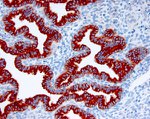Search Thermo Fisher Scientific
FIGURE: 1 / 1
PAEP Antibody (BTE 001-13-02) in IHC (P)

Product Details
BTE 001-13-02
Species Reactivity
Host/Isotype
Class
Type
Clone
Immunogen
Conjugate
Form
Concentration
Purification
Storage buffer
Contains
Storage conditions
Shipping conditions
RRID
Product Specific Information
BTE 001-13-02 detects placental protein 14 from human samples.
BTE 001-13-02 has been successfully used in Immunohistochemistry and ELISA procedures. BTE 001-13-02 reacts strongly to human PP14 in sandwich ELISA in combination with a polyclonal antibody. When staining formalin-fixed paraffin-embedded endometrial tissue from the late secretory phase, staining is restricted to the glandular cells.
NOTE: Concentration is lot-dependent and can vary from 0.85-1.15 mg/mL
Target Information
Human placental protein 14 (PP14; also known as glycodelin and progesterone-associated endometrial protein) is a protein of the lipocalin structural superfamily. PP14 is the most abundant product of the secretory endometrium, and has been proposed as a biochemical marker of endometrial function in women undergoing in vitro fertilization treatment.
For Research Use Only. Not for use in diagnostic procedures. Not for resale without express authorization.
References (0)
Bioinformatics
Protein Aliases: alpha uterine protein; GD; Glycodelin; glycodelin-A; glycodelin-F; glycodelin-S; PAEG; PEG; Placental protein 14; PP14; PP14 protein (placental protein 14); Pregnancy-associated endometrial alpha-2 globulin; pregnancy-associated endometrial alpha-2-globulin; Progestagen-associated endometrial protein; progestagen-associated endometrial protein (placental protein 14, pregnancy-associated endometrial a; Progesterone-associated endometrial protein; ZIF-1; Zona-binding inhibitory factor-1
Gene Aliases: GD; GdA; GdF; GdS; PAEG; PAEP; PEP; PP14
UniProt ID: (Human) P09466
Entrez Gene ID: (Human) 5047

Performance Guarantee
If an Invitrogen™ antibody doesn't perform as described on our website or datasheet,we'll replace the product at no cost to you, or provide you with a credit for a future purchase.*
Learn more
We're here to help
Get expert recommendations for common problems or connect directly with an on staff expert for technical assistance related to applications, equipment and general product use.
Contact tech support
